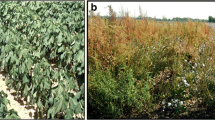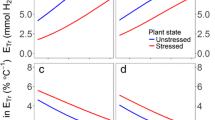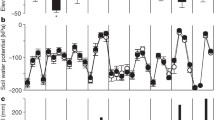Abstract
Since cultivated annual C3 field crops cover about50% of the land surface of the Canadian Prairie grassland eco-climatic zone, this vegetationinfluences the aridity of the climate during the growing season. The physiological response of these cropsto a doubling of the atmospheric concentration of CO2 may be a doubling of canopyresistance. If this physiological effect is not counteracted by interactive feedbacks, such as increasedleaf area, evapotranspiration rates could be reduced. To demonstrate the sensitivity of thearidity of the Prairie climate to this potential physiological effect, representative spring wheatgrowing-season soil moisture and Bowen ratio curves for a doubled canopy resistance(2 × CO2) scenario were compared with a control (1 × CO2) scenario.Lower evapotranspiration in the 2 × CO2 scenario: (1) Increased root-zone soilmoisture levels, and (2) weakened the atmospheric component of the hydrologic cycle by raisingBowen ratios, which reduces the convective available energy, and reduces the regionalcontribution to the atmospheric water vapour over the Prairies. A weakened hydrologic cycleimplies less rainfall, and possibly, lower soil moisture levels. Thus, the net impact of a doublingof the atmospheric concentration of CO2 on the aridity of the Canadian Prairies is uncertain.This simple sensitivity demonstration did not consider most of the potential feedback mechanisms,nor interactions of other processes. Nevertheless, the result illustrates that the physiologicaleffect should be explicitly included in climate change models for the Canadian Prairies.
Similar content being viewed by others
References
Ali, M., Jensen, C. R., Mogensen, V. O., Andersen, M. N., and Hensen, I. E.: 1999, 'Root Signaling and Osmotic Adjustment during Intermittent Soil Drying Sustain Grain Yield of Field Grown Wheat', Field Crop Res. 62, 35–52.
Ash, G. H. B., Shaykewich, C. F., and Raddatz, R. L.: 1992, 'Moisture Risk Assessment for Spring Wheat on the Eastern Prairies: A Water-Use Simulation Model', Clim. Bull. 26, 65–78.
Bazzaz, F. A.: 1990, 'The Response of Natural Ecosystems to Rising Global CO2 Levels', Annu. Rev. Ecol. Syst. 21, 167–196.
Betts, R. A., Cox, P. M., and Woodward, F. I.: 2000, 'Simulated Response of Potential Vegetation to Doubled-CO2 Climate Change and Feedbacks on Near-Surface Temperatures', Global Ecol. Biogeog. 9, 171–180.
Blackman, P. G. and Davis, W. J.: 1985, 'Root to Shoot Communication in Maize Plants of the Effects of Soil Drying', J. Exp. Bot. 36, 39–48.
Bosilovich, M. G. and Schubert, S. D.: 2002, 'Water Vapor Tracers as Diagnostics of the Regional Hydrologic Cycle', J. Hydrometerol. 3, 149–165.
Canada Committee on Ecological Land Classification: 1989, Eco-Climatic Regions of Canada, Ecological Land Classification Series No. 23, Environment Canada, Ottawa, Canada, 118 pp.
Cosby, B. J., Hornberger, G.M., Clapp, R. B., and Ginn, T. R.: 1984, 'A Statistical Exploration of the Relationship of Soil Moisture Characteristics to the Physical Properties of Soils', Water Resour. Res. 20, 682–690.
Douville, H., Planton, S., Royer, J. F., Stephenson, D. B., and Tyteca, S.: 2000, 'Importance of Vegetation Feedback in Doubled-CO2 Climate Experiments', J. Geophys. Res. 105, 14841–14861.
Environment Canada: 1984, Canadian Climate Normals, Vol. 1. Solar Radiation, Supply and Services Canada, Cat. No. En56–601–1982, Ottawa, Canada, 57 pp.
Environment Canada: 1991, The State of Canada's Environment, Chap. 17–Prairie Grasslands, Supply and Services Canada, Cat. No. En21–54/1991E, Ottawa, Canada. pp. 4–8.
Field, C. B., Jackson, R. B., and Mooney, H. A.: 1995, 'Stomatal Responses to Increased CO2: Implications from the Plant to the Global Scale', Plant Cell Environ. 18, 1214–1225.
Gottschalck, J. C., Gilles, R. R., and Carlson, T. N.: 2001, 'The Simulation of Canopy Transpiration under Doubled CO2: The Evidence and Impact of Feedbacks on Transpiration in Two 1–D Soil-Vegetation-Atmosphere Transfer Models', Agric. For. Meteorol. 106, 1–21.
Henderson-Sellers, A., McGuffie, K., and Gross, C.: 1995, 'Sensitivity of Global Climate Model Simulations to Increased Stomatal Resistance and CO2 Increases', J. Climate 8, 1739–1756.
Hunsacker, D. J., Kimball, B. A., Pinter, Jr., P. J., Wall, G. W., LaMorte, R. L., Adamsen, F. J., Leavitt, S. W., Thompson, T. L., Mattias, A. D., and Brooks, T. J.: 2000, 'CO2 Enrichment and Soil Nitrogen Effects on Wheat Evapotranspiration and Water Use Efficiency', Agric. For. Meteorol. 104, 85–105.
Kimball, B. A., LaMorte, R. L., Pinter, Jr., P. J., Wall, G.W., Hunsacker, D. J., Adamsen, F. J., Leavitt, S. W., Thompson, T. L., Mattias, A. D., and Brooks, T. J.: 1999, 'Free-Air CO2 Enrichment and Soil Nitrogen Effects on Energy Balance and Evapotranspiration of Wheat', Water Resour. Res. 35, 1179–1190.
Knapp, H. V.: 1985, 'Evaporation and Transpiration', in D. D. Houghton (ed.), Handbook of Meteorology, John Wiley and Sons, New York, pp. 537–554.
Korner, C.: 2000, 'Biosphere Response to CO2 Enrichment', Ecol. Appl. 10, 1590–1619.
Levis, S., Foley, J. A., and Pollard, D.: 2000, 'Large-Scale Feedbacks on a Doubled CO2Climate', J. Climate 13, 1313–1325.
Mahfouf, J.: 1991, 'Analysis of Soil Moisture from Near Surface Parameters: A Feasibility Study', J. Appl. Meteorol. 30, 1534–1547.
Martin, M., Dickinson, R. E., and Yang, Z. L.: 1999, 'Use of a Coupled Land Surface General Circulation Model to Examine the Impacts of Doubled Stomatal Resistance on the Water Resources of the American Southwest', J. Climate 12, 3359–3375.
Morison, J. I. L.: 1985, 'Sensitivity of Stomata and Water Use Efficiency to High CO2', Plant Cell Environ. 8, 467–474.
Morison, J. I. L.: 1987, 'Intercellular CO2 Concentrations and Stomatal Response to CO2', in E. Zeiger et al. (ed.), Stomatal Function, Stanford University Press, Stanford, CA, pp. 229–251.
Noilhan, J. and Planton, S.: 1989, 'A Simple Parameterization of Land Surface Processes for Meteorological Models', Mon. Wea. Rev. 17, 536–549.
Oke, T. R.: 1987, Boundary Layer Climates, 2nd edn., Methuen, London, 435 pp.
Philip, J. R.: 1957, 'Evaporation, and Moisture and Heat Fields in Soils', J. Meteorol. 14, 354–366.
Pollard, D. and Thompson, S. L.: 1995, 'The Effect of Doubling Stomatal Resistance in a Global Climate Model', Global Planet. Change 10, 1–4.
Polley, H. W.: 2002, 'Implications of Atmospheric and Climate Change on Crop Yield and Water Use Efficiency', Crop Sci. 42, 131–140.
Polley, H. W., Mayeux, H. S., Johnson, H. B., and Tischler, C. R.: 1997, 'Viewpoint: Atmospheric CO2, Soil Water, and Shrub/Grass Ratios on Range Lands', J. Range Manage. 50, 278–284.
Rabin, R. M., Stadler, S., Wetzel, P. J., Stensrud, D. J., and Gregory, M.: 1990, 'Observer Effects of Landscape Variability on Convective Clouds', Bull. Amer. Meteorol. Soc. 71, 272–280.
Raddatz, R. L.: 1989, 'An Operational Agrometeorological Information System for the Canadian Plains', Clim. Bull. 23, 83–97.
Raddatz, R. L.: 1993, 'Prairie Agroclimate Boundary-Layer Model: A Simulation of the Atmosphere/Crop-Soil Interface', Atmos.-Ocean 31, 399–419.
Raddatz, R. L.: 1998, 'Anthropogenic Vegetation Transformation and the Potential for Deep Convection on the Canadian Prairies', Can. J. Soil Sci. 78, 656–666.
Raddatz, R. L.: 2000, 'Summer Rainfall Recycling for an Agricultural Region of the Canadian Prairies', Can. J. Soil Sci. 80, 367–373.
Raddatz, R. L. and Shaykewich, C. F.: 1998, 'Impact of Warm Summers on the Actual Evapotranspiration from Spring Wheat Grown on the Eastern Canadian Prairies', Can. J. Soil Sci. 78, 171–179.
Raddatz, R. L., Ash, G. H. B., Shaykewich, C. F., Roberge, K. A., and Graham, J. L.: 1996, 'First-and Second-Generation Agrometeorological Models for the Prairies and Simulated Water-Demand for Potatoes', Can. J. Soil Sci. 76, 297–305.
Raddatz, R. L., Shaykewich, C. F., and Bullock, P. R.: 1994, 'Prairie Crop Yield Estimates from Modelled Phenological Development and Water-Use', Can. J. Plant Sci. 74, 429–436.
Rowe, J. S. and Coupland, R. T.: 1984, 'Vegetation of the Canadian Plains', in G. J. Mitchell (ed.), Man: User and Modifier of Canadian Plain's Resources, Prairie Forum 9, No. 2, University of Regina, Canadian Plains Research Centre, Regina, SK, pp. 231–248.
Segal, M., Arritt, W., and Clark, C.: 1995, 'Scaling Evaluation of the Effect of Surface Characteristics on the Potential for Deep Convection over Uniform Terrain', Mon. Wea. Rev. 123, 383–400.
Shaykewich, C. F., Ash, G. H. B., Raddatz, R. L., and Tomasiewicz, D. J.: 1998, 'Field Evaluation of a Water Use Model for Potatoes', Can. J. Soil Sci. 78, 441–448.
Shuttleworth, W. J.: 1993, 'Evaporation', in D. R. Maidment (ed.), Handbook of Hydrology, McGraw-Hill, New York, pp. 4.1–4.53.
Wang, Y. P. and Leuning, R.: 1998, 'A Two-Leaf Model for Canopy Conductance, Photosynthesis and Partitioning of Available Energy I:Model Description and Comparison with aMulti-Layered Model', Agric. For. Meteorol. 91, 89–111.
Wetzel, P. J. and Chang, J. T.: 1987, 'Concerning the Relationship between Evapotranspiration and Soil Moisture', J. Clim. Appl. Meteorol. 26, 18–27.
Wilson, K. B., Carlson, T. N., and Bunce, J. A.: 1999, 'Feedback Significantly Influences the Simulated Effect of CO2 on Seasonal Evapotranspiration from Two Agricultural Species', Global Change Biol. 5, 903–917.
Wullschleger, S. D., Tschaplinski, T. J., and Norby, R. J.: 2002, 'Plant Water Relations at Elevated CO2-Implications for Water-Limited Environments', Plant Cell Environ. 25, 319–331.
Author information
Authors and Affiliations
Rights and permissions
About this article
Cite this article
Raddatz, R.L. Aridity and the Potential Physiological Response of C 3 Crops to Doubled Atmospheric Co 2 : A Simple Demonstration of the Sensitivity of the Canadian Prairies. Boundary-Layer Meteorology 107, 483–496 (2003). https://doi.org/10.1023/A:1022186716121
Issue Date:
DOI: https://doi.org/10.1023/A:1022186716121




